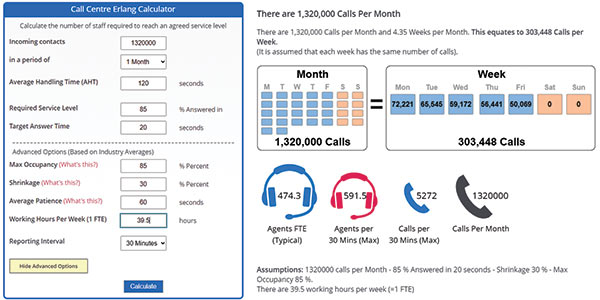12th April 2022

Calculating the number of Full-Time Equivalents (FTEs) in a call centre can be complex, especially when factoring in call volume, service levels, and working hours.
So when members reached out to our Community of industry professionals about this, we thought it would be great to share their questions and the responses with you.
Stells asked our community:
I need to calculate the number of FTEs in a Call Centre.
What I have is:
How many FTE do I need?
You need to break down the calls by half hour and then you need to use a call centre calculator. (This is often known as an Erlang Calculator).
Here is a link to an Online Erlang Calculator
Also here is an Excel based one – I’ve entered in the figures you provided and for these requirements, you would need an FTE of 474.3.
Here is an example of how you would work out the required FTE using an Erlang Calculator:

Contributed by: Jonty
rabby also asked our Community for some advice on working out required FTE:
I need assistance regarding working out my FTE requirements:
How many FTEs do I require for this?
The best way to do this is using an Erlang Calculations.
You first need to split your calls across a week and then by hour to match your profile. You then use the Erlang spreadsheet to calculate the raw number of people you need every hour.
There is a spreadsheet here
There is also an Online Erlang Calculator – I’ve entered in the figures you provided and for these requirements you would need an FTE of 40.3. You can also improve the accuracy of the Erlang Calculator by adding in specific details under advanced options to take into account occupancy, shrinkage, etc.
Contributed by: Jonty
rabby also continued to ask for more advice on contact centres that have a seven day operation with five day working weeks:
Similarly if its a 7 day operation, how many FTE do we require if all agents will be working 5 days per week?
It tends to depend upon your traffic profile.
I tend to find that on average 22% of the volume comes in on a Monday and that tails down to 17% by Friday. You will also need to work out your daily call arrival profile. You can probably get this off your current phone system.
You will also need to build in a “shrinkage factor” typically around 50-70% to allow for time off phones such as meetings, holiday, sickness etc.
Contributed by: Jonty
RAHUL asked our community for advice on whether or not their FTE calculation was correct:
Is this FTE calculation correct?
What you have worked out is the average traffic intensity. Unfortunately the average is not of much help.
You need to put this into an Erlang Calculator
So Assuming
This with a typical traffic profile gives as peak of 1,312 calls per half hour.
This is much higher than the 70.8 advisors that you suggest.
You must factor in
Try for yourself on using this Free Erlang Calculator
Contributed by: Jonty
Teena posed a question about calculating FTE for agents handling emails:
Can I apply the Erlang Calculator to calculate how many agents I need to complete incoming emails in a contact centre?
For example, we are to receive 1200 emails in a period of 24 hours, we work a clean 8 hours in a day and our average responses per hour targeted is about 6.3 emails.
We are targeting a SL of a minimum 85%. If the Erlang Calculator is not suitable, is there any other recommended tool? Thank you very much in advance!
Yes you can also use the Erlang Calculator to work out emails as well, or you can add it into the Multi Channel Simulator
Contributed by: Jonty
This article was made possible due to the great community of experts we have at Call Centre Helper, to get involved just join our LinkedIn Community and and if you aren’t already make sure you are following us on LinkedIn to see our latest content.
You might also find these articles helpful to read next:
Reviewed by: Hannah Swankie